Panasonic Lumix DMC-GH1
-
-
Written by Gordon Laing
Panasonic Lumix DMC-GH1 Movie Mode
The major difference between the Lumix G1 and Lumix GH1 is the latter’s ability to record HD video. Panasonic is of course an established player in the HD camcorder market, so it’s not surprising to find the GH1’s capabilities ticking most of the boxes of demanding videophiles, while also addressing many of the issues facing existing models.
In terms of raw specifications, the Lumix GH1’s video is certainly an impressive proposition. Unlike most cameras which only offer either 720p or 1080p recording, the GH1 gives you the choice of both, encoded using the highly efficient AVCHD compression system; alternatively you can record in 720p or standard definition modes in the Motion JPEG format. Again unlike most digital cameras, the GH1 can also auto-focus while filming, and additionally offers full manual control over the aperture, shutter and ISO if desired. The 14-140mm kit lens is even designed with video in mind, boasting smooth and quiet aperture adjustment.
Panasonic has also equipped the GH1 with half-decent stereo microphones, a 2.5mm jack for an external microphone, and a dedicated button to start and stop recording. And like other cameras with large sensors and interchangeable lenses, the GH1 enjoys respectable low-light performance, the potential for a shallow depth-of-field and the chance to film with specialist optics.
Panasonic’s clearly done its homework and, on paper at least, the Lumix GH1 has arguably the most proficient video mode of all still cameras (even though you can’t take stills while filming). With the choice of recording formats along with Aperture and Shutter Priority modes, it offers greater shooting flexibility than Canon’s EOS 5D Mark II (even with its latest firmware update), although the Canon still has the advantage of a much larger sensor and considerably broader lens catalogue.
Recording formats
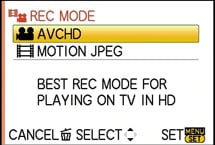 | 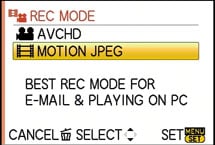 |
As mentioned above, the GH1 offers the choice of AVCHD or Motion JPEG formats. AVCHD applies more compression, and therefore squeezes more footage onto your card, although subsequently becomes trickier to play and edit on your computer. In contrast, Motion JPEG employs milder compression which may eat through your memory quicker, but is considerably easier to play and edit on your computer.
If you mostly intend to play video on the camera or a connected TV, then AVCHD is your best bet, but if you intend to edit footage, you’ll find Motion JPEG easier to work with. That said, you may end up using AVCHD regardless, as Motion JPEG files on the GH1 are limited to 2GB in size and resolutions no higher than 720p. In contrast, AVCHD offers a Full HD option, along with higher compression and recording limited only by remaining space.
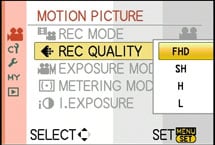 | 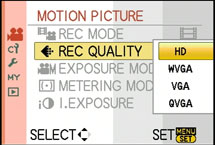 |
With the Lumix GH1 set to the AVCHD format, you can choose from four quality modes: FHD, SH, H and L. FHD records in Full HD 1080p (1920×1080 pixels) at 17Mbit/s. SH, H and L all record in 720p (1280×720 pixels) at 17, 13 and 9Mbit/s respectively. With the GH1 set to Motion JPEG, you can also choose from four quality modes, but this time each with different resolutions: the HD, WVGA, VGA and QVGA modes record at 1280×720 848×480, 640×480 and 320×240 pixels respectively. So once again, if you want Full HD, you’ll need to record in the AVCHD format.
The difference in compression becomes clear when you compare what you’d squeeze onto a typical card. For example, fit a 2GB card in the GH1 and you could record around 8 minutes and 20 seconds of Motion JPEG in 720p. Switch to AVCHD and the same card could accommodate 15 minutes of footage in either 720p or 1080p. If you fitted a bigger card, the GH1, would still be limited to 8 minute clips when filming in 720p Motion JPEG, but AVCHD would keep recording until you ran out of space. Fit a 32GB card and your HD AVCHD clips could last up to four hours.
Another difference between the two formats is their location on the card itself. Motion JPEG ‘MOV’ files may be found alongside your still photos in the DCIM folder, but the AVCHD ‘MTS’ files are buried away in various nested folders which start with one unhelpfully labelled PRIVATE on your card. This is to ensure compatibility with Panasonic’s TVs, and to play them on your computer, simply point your software at this folder and it’ll work out the rest; we had no issues playing back in Cyberlink’s PowerDVD 8 which ‘saw’ them as a Blu-Ray disc. Either way, just remember to copy the MTS files out of this folder before reformatting your card.
One final note on MTS – it may be standard for Panasonic’s AVCHD cameras, but many programs and services are not compatible. For example at the time of writing, Vimeo wouldn’t accept MTS files in their native format, so to show you example footage we needed to convert them using Adobe Media Encoder into ‘MP4’ files using the same compression. So if you intend to edit AVCHD footage from the GH1, ensure your software is either natively compatible with MTS files, or you have some means to convert them first. We used Adobe Premiere Pro CS4 to natively edit the MTS files in our compilation below.
Frame rates
While Canon’s and Nikon’s DSLRs with movie modes are all locked to 30 or 24fps respectively, the GH1’s frame rate depends on a number of factors. Motion JPEG is easiest to explain, as all four quality modes are simply recorded at 30fps. AVCHD is somewhat more complicated though and depends both on the quality setting and the camera’s geographic region.
If it’s an NTSC model, the FHD signal is output from the sensor at 24fps, but actually recorded as an interlaced 60i file. If you’re using the SH, H or L modes on an NTSC model, the sensor outputs 60fps and this is recorded as a 60p file.
If you’re using a PAL model, the FHD signal is output from the sensor at 25fps, but recorded as an interlaced 50i file. And if you’re using the SH, H or L modes on a PAL model, the sensor outputs 50fps and records it at a 50p file.
Panasonic explained its conversion of progressive 1080 video into interlaced formats had advantages for TV playback, while also ensuring compatibility with iMovie. The latter’s certainly true, but ultimately we’d have preferred 1080 video in the native 24p and 25p formats, or at least the option to record them instead of the interlaced versions.
This decision won’t affect most casual videographers, but enthusiasts or independent film makers would have much preferred the native formats, and should a firmware update in the future unlock them, Panasonic could look forward to selling the GH1 to a more demanding, specialist customer.
Note: some may be initially concerned the 1080p FHD mode employs the same 17Mbit/s rate as the 720p SH mode, which implies a much higher rate of compression for the former. But the difference in sensor frame rates essentially balance it out, with 1080p at 24 or 25fps delivering roughly similar data throughput to 720p at 50 or 60fps, and hence similar compression ratios given the same bit rate.
Focusing
While most rival cameras demand manual focusing on their movie modes, the GH1 offers the choice of manual or auto-focusing during filming. Unsurprisingly though, there are still a number of restrictions to be aware of.
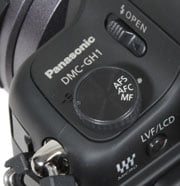 |
Auto-focusing while filming is continuous (whether the dial is set to AFS or AFC), but is highly dependent on the lens in question. Fit the 14-140mm kit lens (or future models labelled with the HD symbol) and you’ll enjoy continuous auto-focus, along with quiet adjustment of the focusing and aperture. Fit any other Micro Four Thirds lens though and the AF may not work so well – indeed Panasonic warns it won’t operate in the top quality FHD mode at all. The sound of the AF system and aperture adjustments may also be recorded.
Fit a Four Thirds lens that’s compatible with Contrast-AF via an adapter and further restrictions apply – depending on the model, you may only be able to auto-focus when you half-press the shutter. Fit a Four Thirds lens which doesn’t support Contrast-AF and you can forget autofocus during movies altogether.
So for the best experience, you’ll need to use an ‘HD’ compatible Micro Four Thirds lens, and at the time of writing, that was limited to Panasonic’s own G VARIO 14-140mm. The two Olympus Micro Four Thirds lenses launched with the E-P1 (along with Panasonic’s existing non-HD Micro Four Thirds lenses) will autofocus in the GH1’s movie mode, but Panasonic warns of reduced tracking speed, audible AF and aperture adjustments, along with the inability to autofocus in the best-quality FHD mode. The latter is an interesting restriction which means right now, there’s only one lens which will continuously autofocus in the FHD mode, and even then, as we discovered, it may not necessarily do it as confidently as in the 720p mode.
There’s a full and updated list of lens compatibility and restrictions at Panasonic Japan. If it’s all too much for you though, remember you can always just autofocus before filming, then switch manual focus like most rival cameras.
Exposures
 |
While auto-focusing on the Lumix GH1 involves a number of restrictions, the exposure control is much more straightforward – well, apart from one slightly unintuitive aspect anyway. The GH1 may let you film using any of the mode settings on the main dial (including scene presets and iA modes for specific or automatically recognised subjects), but set it to PASM and it becomes fully automatic. Confusingly, if you want to use program, manual, aperture or shutter priority, you’ll first need to set the mode dial to the Creative Manual setting, then choose P, A, S or M from an on-screen menu. Panasonic explains this is becuase the shutter speed range is lower in the movie mode than it is for stills.
Once you’re in the desired mode though, it all becomes very natural. Simply adjust the aperture or shutter as you would with normal still photos, with the entire range of apertures at your disposal, along with exposures from 1/30 to 1/4000. Sensitivity can be left to automatic, varying between 100 and 1600 ISO, or set manually from the same range. Note, by updating the camera’s firmware to version 1.1 or later (released June 2009), the GH1 can enjoy an extended shutter speed range for movies down to half a second, but only under very strict conditions: to access shutter speeds between 1/2 and 1/30, the quality must be set no higher than 720p and both the exposure and focusing modes must be set to manual. If you want AF or FHD, the slowest shutter is still limited to 1/30.
The ability to adjust any aspect of the exposure is very welcome on the GH1, and the addition of Aperture and Shutter Priority even takes it beyond the manual control offered by Canon’s EOS 5D Mark II when running its latest firmware.
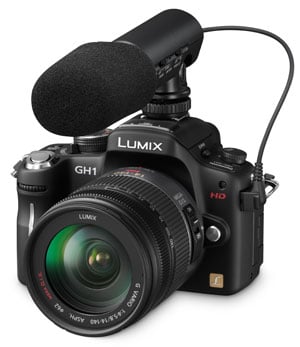 |
Audio
Video is of course only one part of the movie experience, and thankfully Panasonic has also taken care with the audio side of things.
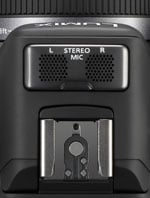 |
Unlike the tiny built-in mono microphones of most rival cameras, the GH1 boasts a pair of decent-sized stereo microphones atop its viewfinder head – these are more akin to what you’ll find on a dedicated camcorder, and you can hear how the camera sounds in our sample footage below. The GH1 also offers three Wind Cut options in the Motion Picture menu.
Like most rivals though, the built-in microphones can record some operational sounds, such as focusing or aperture adjustments. Performing as advertised though, the G VARIO 14-140mm lens can adjust its focus and aperture silently while filming. Interestingly, we noted that while the G VARIO 7-14mm audibly clicked prior to filming, its aperture adjustments were also silent once filming commenced.
Again taking it beyond most rivals is the ability to connect an external microphone via a 2.5mm jack on the side of the body, which shares its functionality with the existing remote socket. Panasonic sells the optional DMW-MS1 microphone which mounts on the flash hotshoe and offers either stereo or mono recording.
Performance in action
Phew, with all the technicalities out the way, what’s the actual quality like? Below is a compilation of clips taken under a variety of conditions using the FHD mode to give you an idea. Note these were filmed with a PAL model, so the original footage was recorded at 1080i / 50Hz. For viewing via Youtube, the footage was reduced in size to 720p, although we have samples you can download later.
| |||||
Composing with the GH1’s articulated screen is certainly very easy, although ergonomically, the camera’s form factor isn’t particularly comfortable for extended shooting. Panasonic may have also designed the G VARIO 14-140mm kit lens with video in mind (thanks to silent focus and aperture adjustments), but like rival models, it’s still hard to adjust the zoom ring smoothly, or without twisting the camera. Switching between the GH1 and a camcorder or a super-zoom digital camera makes you appreciate just how useful a motorised zoom is. But the same criticism applies to DSLRs with movie modes, so we’ll move on.
The auto-focusing while filming really does work, although interestingly the GH1 finds it easier at the lower quality 720p modes. Set it to the best-quality FHD 1080p mode and the auto-focus adjustments are slower and less confident, especially with moving subjects or sequences where the zoom is operated. You can see an example of this with two clips below, both showing similar sequences including a full zoom of the 14-140mm lens, but the second clip, filmed in 1080p, exhibits noticeably slower focusing with more searching than the version in 720p. Panasonic explained this is because the 720p mode (capturing 50 or 60 images per second) provides the AF system with more information than the 1080p mode which only captures 24 or 25 images per second. It’s this extra information which allows the faster AF performance in the 720p mode.
Both clips also illustrate how the GH1’s video performance can be tripped-up by handheld pans, zooms and wobbles much more so than a traditional camcorder, so if you typically film using casual techniques, it may not be the model for you. Note the lens stabilisation was enabled, but the wobbles at the end of the clip are due to trying to zoom the lens while handheld – it’s very difficult to do so smoothly. Registered members of Vimeo can download copies of these two clips for further analysis: GH1 720p clip / GH1 1080p clip. You can also see how it compares against Canon’s EOS 5D Mark II, along with two popular super-zooms (the Canon SX1 IS and Sony HX1) in our 1080p video shoot-out.
Panasonic Lumix DMC-GH1 handheld clip in 720p
Panasonic Lumix DMC-GH1 handheld clip in 1080p
But given the fact its rivals are manual focus only, the GH1’s auto-focus performance is still impressive – but if you want quick AF, you may prefer to shoot in 720p mode. And remember, this is also the mode you’ll need for autofocus when using non-HD compatible lenses.
Once you’ve figured-out how to change the exposure mode via a menu and not the main dial, the manual options are a joy to use. It really is a doddle to select the desired aperture or shutter, or lock the camera down to a specific result.
The only caveat here though are the available optics limit the possibility of a really shallow depth of field, especially if you’re using the G VARIO 14-140mm kit lens –it’s tricky to achieve a blurred background or selective focusing with this lens unless you’re fully zoomed-in and close to your subject. You could of course fit a bright Four Thirds lens via an adapter, although of course suffer from the AF restrictions mentioned above. What’s really needed are some bright, longer primes in the Micro Four Thirds format, and only time will tell if they’ll be forthcoming.
Remaining on the subject of lenses, Panasonic’s ultra-wide Micro Four Thirds zoom, the G VARIO 7-14mm is great fun to use in the movie mode, especially set to its widest equivalent focal length of 14mm. You can enjoy some really fun effects, even though as a non-HD lens it becomes manual focus only in the best quality FHD mode. That said, as mentioned above, the aperture adjustments were quiet with this lens during filming even though it isn’t an ‘HD’ model.
Ultimately the Lumix GH1 delivers the most seamless video experience for a DSLR-style camera to date. Unlike rival models it really does autofocus quite effectively while filming (so long as you’re using an HD lens and ideally the 720p format), and there’s also full and easy control over exposures, along with a choice of resolutions and encoding formats.
But like DSLRs with movie modes, handheld footage can suffer from undesirable ‘jello’ artefacts, especially if you’re attempting to adjust the lens zoom. If you want to film casual footage that’s predominantly handheld and includes zooms, then a dedicated camcorder remains your best bet. Canon’s EOS 5D Mark II will also be preferred by independent film makers who are willing to work around its technicalities and exploit its larger sensor and broader lens catalogue.
But if you want a hybrid model which offers a better automatic experience than the 5D Mark II along with full manual control when you need it, then the GH1 is hard to beat. Panasonic’s raised the bar for interchangeable lens cameras with video capabilities, although again to get the most from the GH1’s movie mode, you’ll need to be using it with an HD-compatible lens, and right now, that’s only the kit zoom.




